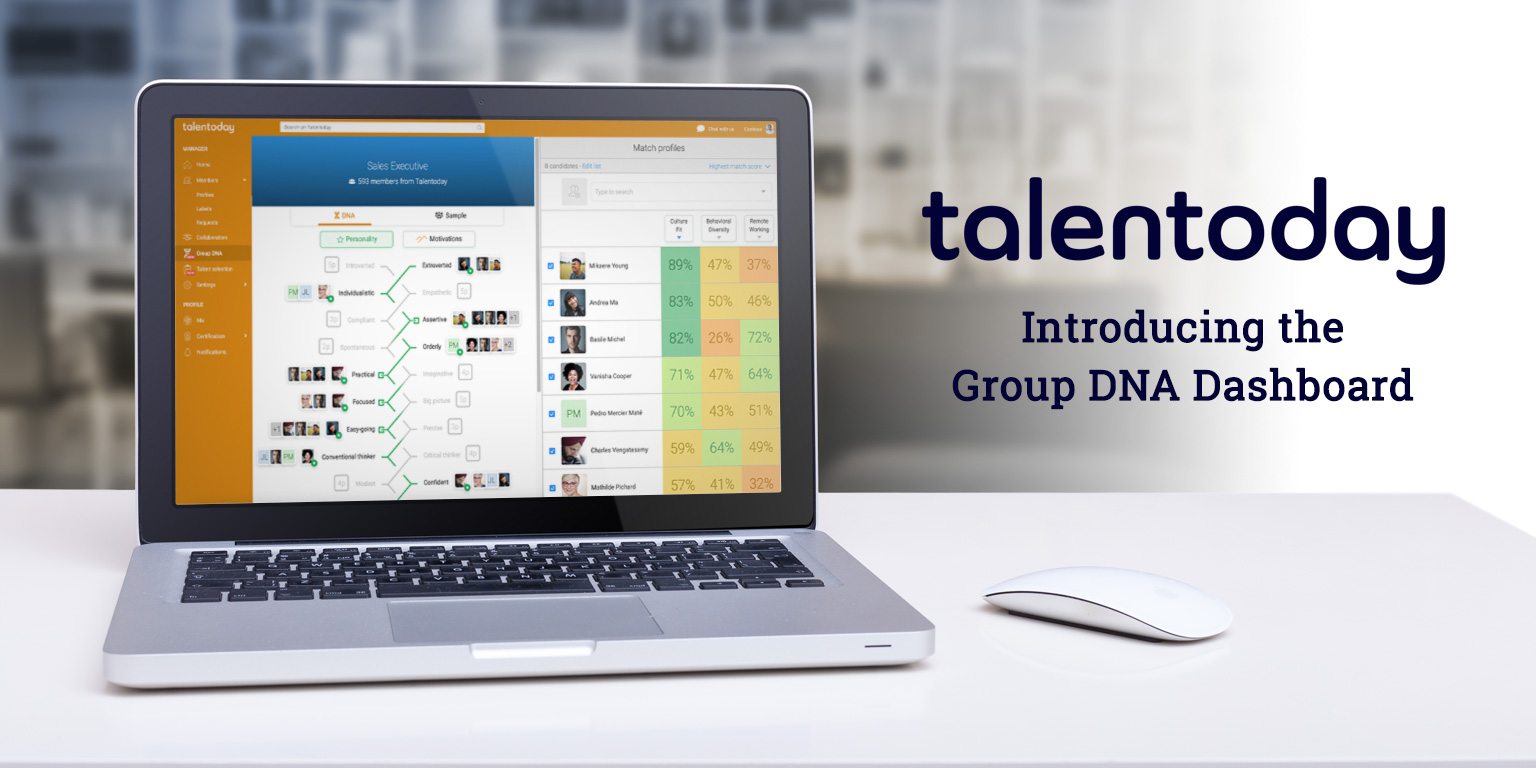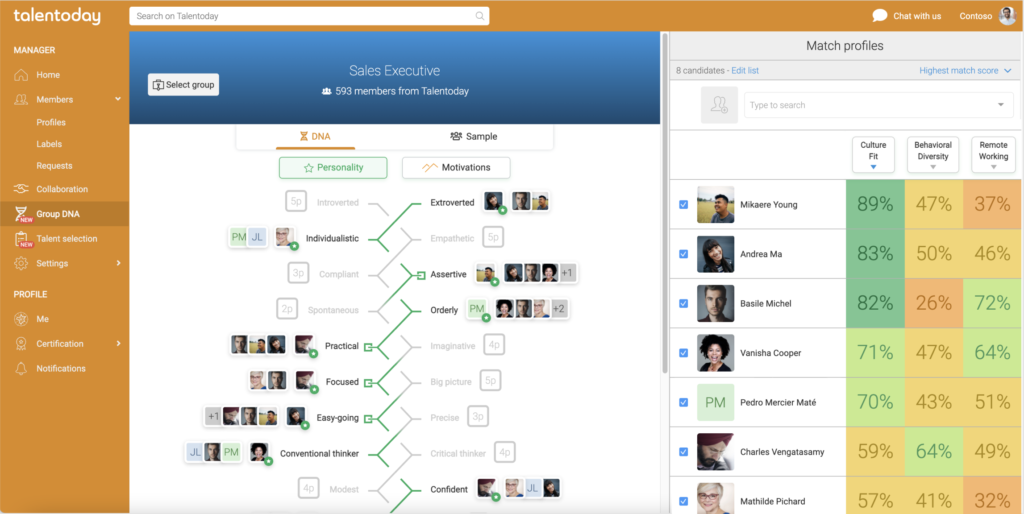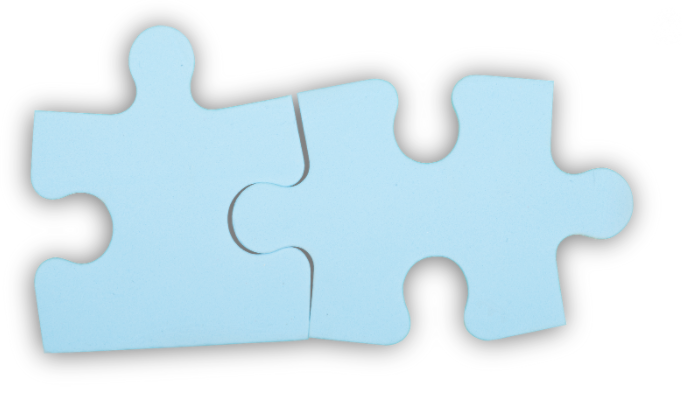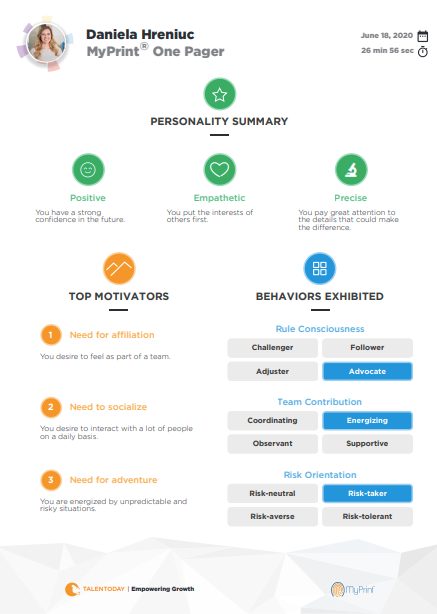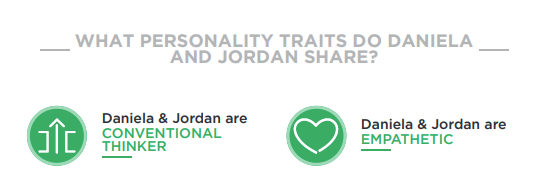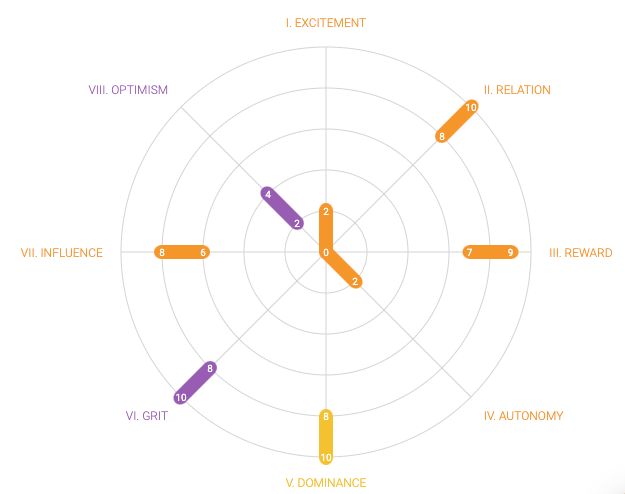Visualize Team Connections with the Group DNA Dashboard
Recruiting and building teams based on hard skills alone has proven to be an inefficient and incomplete hiring and management strategy in today's world of work. That’s why Talentoday has created the Group DNA Dashboard. It’s a new way to visualize the team profiling and talent matching tools first introduced by Group DNA (GDNA).
Now available in the Talentoday Manager platform, this powerful analytics tool leverages soft skill data to paint a complete cultural picture of a team, company or position. Users can also compare this key information alongside individual profiles to draw important connections between teammates.
Here’s how HR professionals can use the Group DNA Dashboard to power better decision making.
Discover the Group DNA Dashboard
Talentoday’s Group DNA Dashboard helps HR leaders visualize three key areas of people analytics: Culture Fit, Behavioral Diversity and Remote Work.
First, the new dashboard assesses culture fit, a key indicator of potential employee retention rate. This is done by evaluating how an individual matches with the predominant poles of the GDNA, zeroing in on personality traits and motivations that reflect the core values of the targeted team or company.
Second, the tool provides an analysis of behavioral diversity. This is a representation of the potential prevalence of diversity of thought, varied opinions and creative viewpoints in the workplace. To calculate this percentage, the GDNA Dashboard calculates the extent to which an individual diverges from the non-predominant poles of the Group DNA. The higher the percentage of distance, the more an individual can bring balance to the behaviors of a targeted team or company.
Finally, the GDNA Dashboard was built with today’s workplace in mind, dedicating space for key remote working insights. Individual profiles are compared against the results of our Remote Worker Group DNA profile to identify which teammates may excel in a work-from-home or hybrid environment.
Personalizing Your Results
In addition to visualizing these results all at once, users can also sort any matching results according to culture fit, behavioral diversity or remote working ability. This ensures that your decision making process can be as granular as you want it to be.
For example, a design team may be most interested in building their team around creative thinking. In this case, users could use the dashboard to maximize behavioral diversity matches.
On the other hand, a technology team may put more emphasis on boosting retention rates in a tight labor market. To attract the right talent with the skills needed to succeed, this might mean focusing on offering work flexibility and remote work opportunities. Therefore, this team’s dashboard may filter for remote work abilities to find the top matches in these asynchronous environments.
Visualize Team Connections with the Group DNA Dashboard
Interested in seeing how the Group DNA Dashboard helps leaders identify soft skills connections on their teams? Contact our Talentoday team today to learn more about how our latest feature is changing the way teams visualize and act upon soft skills data!
Build Your Team Using Soft Skills
In the pandemic-impacted spring of 2020, puzzle sales were up 300% from the year prior¹. I have to admit that I contributed more than my share to that increase in sales; you can only watch so much Netflix before you need to find a new in-home activity!
What I’m trying to say is that I spent a lot of time in front of puzzles this year and I’ve learned one valuable lesson: teams are a lot like puzzles. That is our metaphor for today.
We don’t always know what our missing pieces will look like
When you are looking for the perfect piece for your puzzle you might have the exact picture of what you are looking for in your head. You know what the surrounding pieces look like (what their strengths are) and you just need to find the piece that looks like those ones. The problem with putting too many constraints on what we want is that oftentimes as human beings we’re wrong. Although there might be certain characteristics that we know we need for a position, that doesn’t mean that we know all of the important aspects.
When interviewing candidates, it might seem like we know exactly what soft skills are needed for success. After all, why wouldn’t you just find someone who looks just like your top performers? To start, there are a lot of positions where two opposing traits can come in handy! Someone who is extroverted can be just as successful in a position as someone who is introverted. Same goes for people who are patient versus being eager, or imaginative versus practical. That brings us to our next point — similarities and differences.
Some pieces look similar, but the differences in pieces are what create the whole picture
When every person on your team thinks exactly the same way, you lose something very important in teamwork: Diversity of Thought². When hearing this term you might automatically think of gender, race, background, or age. While all of these things are important, another aspect of diversity can come in when looking at — that’s right — soft skills.
When teams are collaborating on a project there are aspects of their personality or motivations that can be helpful to have similarities in. However, if you have a team full of extroverted people, you might find it hard to get on track. If your team is full of big picture thinkers, you might find yourself with a lot of ideas and not a lot of action items. If everyone on the team is very precise, you might end up spending more time on the details than necessary. Find the gaps in your team and keep that in mind when you are looking for new people to join your organization.
Each piece is unique and has a place, even if it’s not where you originally thought
Let’s say you hire an individual who you thought was the perfect fit for a team and they’re not doing quite as well as you thought. Before giving up on that person take some time to get to know their soft skills. What are their personality strengths? Are you utilizing these strengths in their position? Do these strengths have a place in their current position in the team? What motivates this person? Are you fulfilling those motivations as a manager or teammate, or is their work fulfilling those motivations?
See if there is another place where that individual can thrive, even if there are some skill gaps to address. People are the most important asset to an organization³ so before getting rid of a good hire, see if they were just in the wrong position.
Once your pieces are where they belong, you can create something amazing!
Every person is unique. Even when there are shared qualities within a team nobody thinks, is motivated, or behaves in the exact same way. Those differences are what make a team stronger, more creative, and ready to tackle whatever challenges they might face!
Using MyPrint® to put together your team
For more ways to understand your team’s soft skills on an individual and group level, check out our MyPrint® assessment and keep reading to learn more about some of our features included in the Talentoday Manager platform!
One Pager: Use this one page summary of an individual’s results to see their top 3 personality strengths, top 3 motivators, and 3 most prominent professional behaviors.
Premium Report: This 20+ page report gives in depth information about every personality and motivation dimension that is measured in the MyPrint® assessment, including strengths and tips to working with that individual. Additional information about the 11 professional behaviors are included, along with suggested interview questions to help you go more in depth when getting to know someone!
Collaboration Report: View two individuals’ most similar and different personality traits, as well as top motivators and behavior synergies in a side-by-side comparison.
Target Profiles: Use pre-made templates or create your own target profile to see where your team has similarities. From there you can determine if these traits are beneficial to the position, or use this tool to determine the soft skill gaps in your team!
Stay tuned for some new, exciting features in 2021! Get more insights on your team as a whole on all personality and motivation dimensions, as well as understanding how individuals’ behaviors synergize with one another.
Looking for additional resources and support? Email Talentoday at customer@talentoday.com to learn more about our assessment and services!
Sources
²https://www.businessinsider.com/the-future-of-workplace-diversity-is-here-2013-9
HR Managers are Redefining Merit to Justify Discrimination
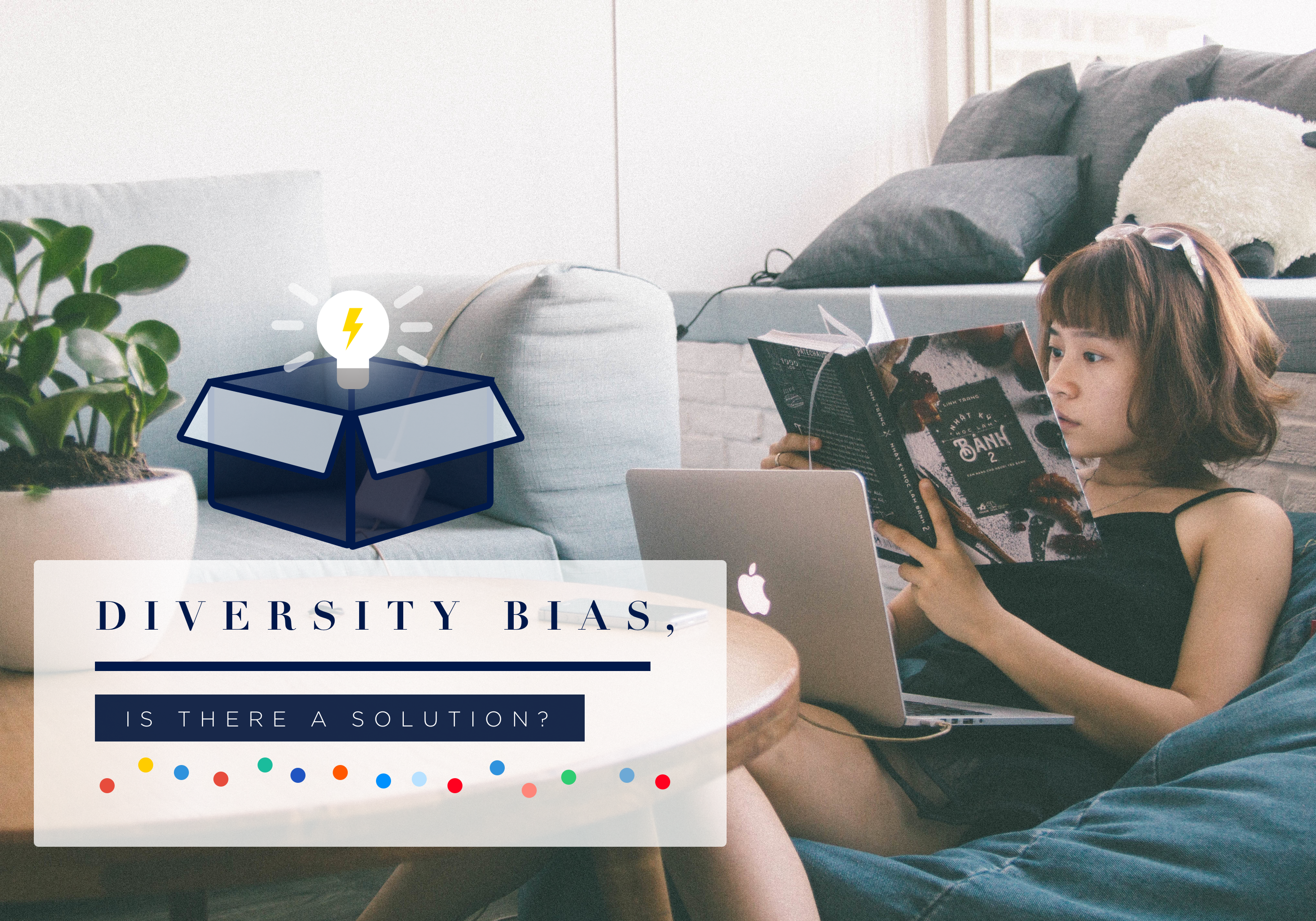
Studies show that gender and culturally diverse companies are more successful. This report from McKinsey found that businesses that are gender diverse are 15% more likely to financially outperform homogenous companies, and businesses that are ethnically diverse are 35% more likely to outperform less diverse ones.
Yet, according to this study by Yale researchers, decision makers may downplay the importance of a female applicant’s areas of expertise and inflate the importance of her areas of weakness. Alternatively, decision makers may view the credentials of a specific male applicant as essential to job success and view his areas of weakness as nonessential.
Many companies are trying to improve diversity, or at least claiming they are. Earlier this year, Airbnb announced they assembled a team of civil rights leaders (including the former Attorney General Eric Holder) to review and update the company’s anti-discrimination policies. “I want us to be smart and innovative and to create new tools to prevent discrimination and bias that can be shared…” said co-founder Brian Chesky in this blog post.
Blogger Erica Jones candidly discussed her own experience being the sole black woman on various IT teams, encountering racial bias’ both blatant (degrading comments by coworkers) and clandestine (the company hiring out on a project Jones was the most qualified to do). Jones said,
“I am a black woman who happens to work in the tech industry. I don’t need to change to fit within my industry. My industry needs to change to make everyone feel included and accepted.”
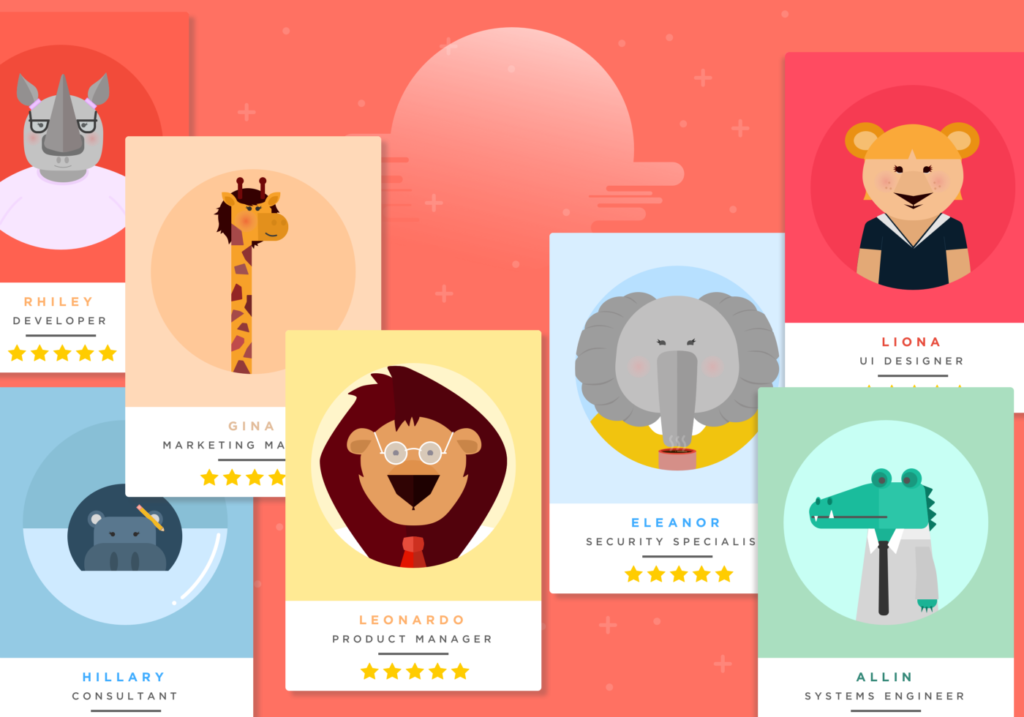
Some companies are making progress on gender diversity. Fortune recently reported that food-delivery company Grubhub has seen success with 50% of its executives being women, 43% of its workforce, and 23% of its engineers (10% more than U.S. average).
Recruiting talent from a larger pool of backgrounds lends itself to a more balanced team. One can see how, in this analysis by Talentoday who reviewed real personality comparisons by country:
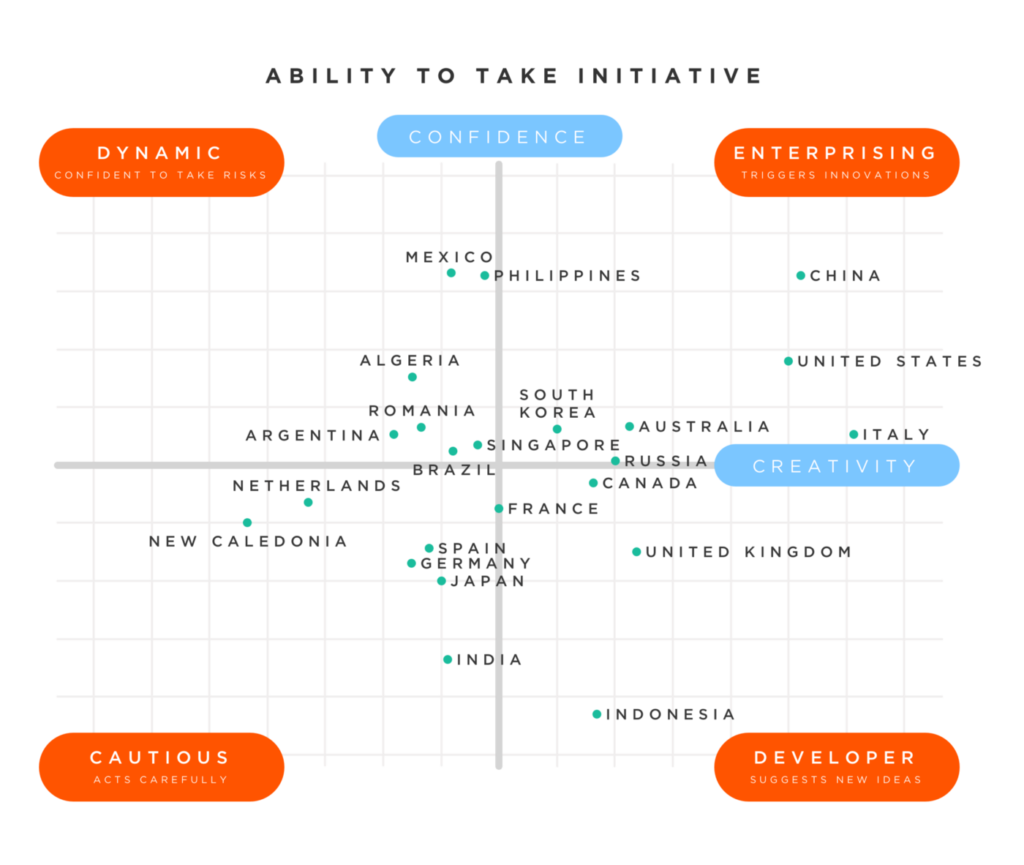
Having a team of dynamic, cautious, enterprising and developer mindsets is ideal — for balanced idea generation and execution. The enterprising person inspires the developer, the dynamic person’s boldness is balanced by the cautious. As the graph above shows, if one only hires people from the U.S. it can be harder to obtain such a diverse team.
Avoiding discrimination bias and fostering a culturally and gender diverse team begins with the hiring manager. Companies who try to do diversity well often make the mistake of casting a wide net initially, but bias’ show up in the final selection. Hiring managers shouldn’t focus on people that are most similar to him or her, but rather aim for as wide of a range of a group as possible. The real problem lies in the bias of the final selection from recruiters and hiring managers.
Disrupting the Bias
One way managers can minimize their bias may be by evaluating the skills of candidates using a personality assessment tool. This gives managers and recruiters an objective way to look at a persons soft skills to create a team that works best together.
But not all tools are created equal. As Nanette Byrnes wrote in this piece on Technology Review,
“the danger remains that unrecognized bias, just in the programming of an algorithm but even in the data flowing into it, could inadvertently turn any program into a discriminator.”
Algorithms must be specifically tailored to minimize the bias, like objective data found in the Talentoday manager that helps reduce the bias of decision makers. Talentoday takes a look at the motivations and personality traits needed to succeed at a given job. Managers can assess their candidates and match the personality results to the industry standard to find the right fit, scientifically.
Another company has taken a different approach. GapJumpers has reworked the hiring process to include blind interviews modeled after the hit TV series The Voice. Cofounder and CEO, Kedar Iyer, states,
“If one industry, especially a shallow one like the music industry, can do [blind auditions], why can’t tech companies, which are so much more scientific, do them?”
GapJumpers found that male applicants raised concerns about having to prove themselves in a blind test more often than women. Once the blind challenge was completed, the gender breakdown of those candidates hired was 58% women, 42% men.
At the end of the day, in order to interrupt the process of judgment the focus must be shifted to evidence and away from perception. We may be a long way from changing human conditioning but companies can adapt with tools to make the hiring playing field less biased.
Check out our page to send our free personality assessment to your potential new hires today. And if you like this post, please hit the ❤️ button below or give me a shout on Twitter.


